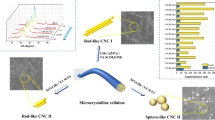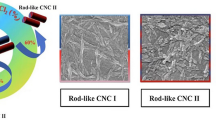Abstract
Mercerized wood cellulose was oxidized by 4-acetamide-TEMPO/NaClO/NaClO2 system at 60 °C and pH 4.8 for 1–5 days. Mostly individual nanocrystals 4–7 nm in width and 100–200 nm in length were obtained by ultrasonication of the oxidized product in water. The nanocrystals had the cellulose II structure, and carboxylate contents of 2.0–2.4 mmol/g, indicating that these carboxylate groups were selectively formed on the cellulose II crystallite surfaces in mercerized cellulose. Moreover, the original wood cellulose and mercerized cellulose were acid-hydrolyzed, and then subjected to the TEMPO-mediated oxidation under the same conditions at pH 4.8 to prepare reference samples. TEM images, light transmittance and rheological properties of water dispersions showed that the nanocrystals prepared from mercerized cellulose by the TEMPO oxidation and sonication in water had the highest dispersibility of individual nanocrystals with less amounts of bundles in water, resulting from the highest carboxylate contents.








Similar content being viewed by others
References
Araki J, Wada M, Kuga S, Okano T (1998) Flow properties of microcrystalline cellulose suspension prepared by acid treatment of native cellulose. Colloids Surfaces A 142:75–82
Beck-Candanedo S, Roman M, Gray DG (2005) Effect of reaction conditions on the properties and behavior of wood cellulose nanocrystal suspensions. Biomacromolecules 6:1048–1054
Dong XM, Revol JF, Gray DG (1998) Effect of microcrystallite preparation conditions on the formation of colloid crystals of cellulose. Cellulose 5:19–32
Favier V, Chanzy H, Cavaille JY (1996) Polymer nanocomposites reinforced by cellulose whiskers. Macromolecules 28:6365–6367
Fukuzumi H, Saito T, Iwata T, Kumamoto Y, Isogai A (2009) Transparent and high gas barrier films of cellulose nanofibers prepared by TEMPO-mediated oxidation. Biomacromolecules 10:162–165
Habibi Y, Chanzy H, Vignon MR (2006) TEMPO-mediated surface oxidation of cellulose whiskers. Cellulose 13:679–687
Hirota M, Tamura N, Saito T, Isogai A (2009a) Oxidation of regenerated cellulose with NaClO2 catalyzed by TEMPO and NaClO under acid-neutral conditions. Carbohydr Polym 78:330–335
Hirota M, Tamura N, Saito T, Isogai A (2009b) Surface carboxylation of porous regenerated cellulose beads by 4-acetamide-TEMPO/NaClO/NaClO2 system. Cellulose 16:841–851
Isogai A, Kato Y (1998) Preparation of polyuronic acid from cellulose by TEMPO-mediated oxidation. Cellulose 5:153–164
Isogai T, Yanagisawa M, Isogai A (2008) Degrees of polymerization (DP) and DP distribution of dilute acid-hydrolyzed products of alkali-treated native and regenerated celluloses. Cellulose 15:815–823
Isogai T, Yanagisawa M, Isogai A (2009) Degrees of polymerization (DP) and DP distribution of cellouronic acids prepared from alkali-treated celluloses and ball-milled native celluloses by TEMPO-mediated oxidation. Cellulose 16:117–127
Kim NH, Imai T, Wada M, Sugiyama J (2006) Molecular directionality in cellulose polymorphs. Biomacromolecules 7:274–280
Langan L, Nishiyama Y, Chanzy H (1999) A revised structure and hydrogen-bonding system in cellulose II from a neutron fiber diffraction analysis. J Am Chem Soc 121:9940–9946
Marchessault RH, Morehead FF, Walter NM (1959) Liquid crystal systems from fibrillar polysaccharides. Nature 184:632–633
Montanari S, Rountani M, Heux L, Vignon MR (2005) Topochemistry of carboxylated cellulose nanocrystals resulting from TEMPO-mediated oxidation. Macromolecules 38:1665–1671
Revol JF, Marchessault RH (1996) Rheological properties of aqueous suspensions of chitin crystallites. J Colloid Interface Sci 183:365–373
Russel WB (1976) Lo-shear limit of the secondary electroviscous effect. J Colloid Interface Sci 55:590–604
Saito T, Isogai A (2004) TEMPO-mediated oxidation of native cellulose. The effect of oxidation conditions on chemical and crystal structures of the water-insoluble fractions. Biomacromolecules 5:1983–1989
Saito T, Nishiyama Y, Putaux JL, Vignon M, Isogai A (2006) Homogeneous suspensions of individualized microfibrils from TEMPO-catalyzed oxidation of native cellulose. Biomacromolecules 7:1687–1691
Saito T, Kimura S, Nishiyama Y, Isogai A (2007) Cellulose nanofibers prepared by TEMPO-mediated oxidation of native cellulose. Biomacromolecules 8:2485–2491
Saito T, Hirota M, Tamura N, Kimura S, Fukuzumi H, Heux Laurent, Isogai A (2009) Individualization of nano-sized plant cellulose fibrils by direct surface carboxylation using TEMPO catalyst under neutral conditions. Biomacromolecules 10:1992–1996
Samir MASA, Alloin F, Dufresne A (2005) Review of recent research into cellulosic whiskers, their properties and their application in nanocomposite field. Biomacromolecules 6:612–626
Shibata I, Isogai A (2003) Depolymerization of cellouronic acid during TEMPO-mediated oxidation. Cellulose 10:151–158
Shibazaki H, Kuga S, Okano T (1997) Mercerization and acid hydrolysis of bacterial cellulose. Cellulose 4:75–87
Zuluaga R, Putaux JL, Cruz J, Velez J, Mondragon I, Ganan P (2009) Cellulose microfibrils from banana rachis: effect of alkaline treatments on structural and morphological features. Carbohydr Polym 76:51–59
Acknowledgments
This research was supported in part by Grants-in-Aid for Scientific Research S (Grant number 21228007) from the Japan Society for the Promotion of Science (JSPS).
Author information
Authors and Affiliations
Corresponding author
Rights and permissions
About this article
Cite this article
Hirota, M., Tamura, N., Saito, T. et al. Water dispersion of cellulose II nanocrystals prepared by TEMPO-mediated oxidation of mercerized cellulose at pH 4.8. Cellulose 17, 279–288 (2010). https://doi.org/10.1007/s10570-009-9381-2
Received:
Accepted:
Published:
Issue Date:
DOI: https://doi.org/10.1007/s10570-009-9381-2




